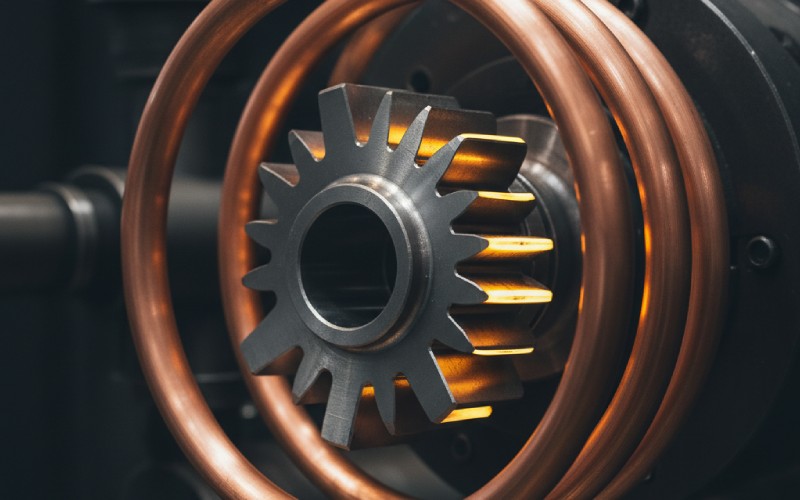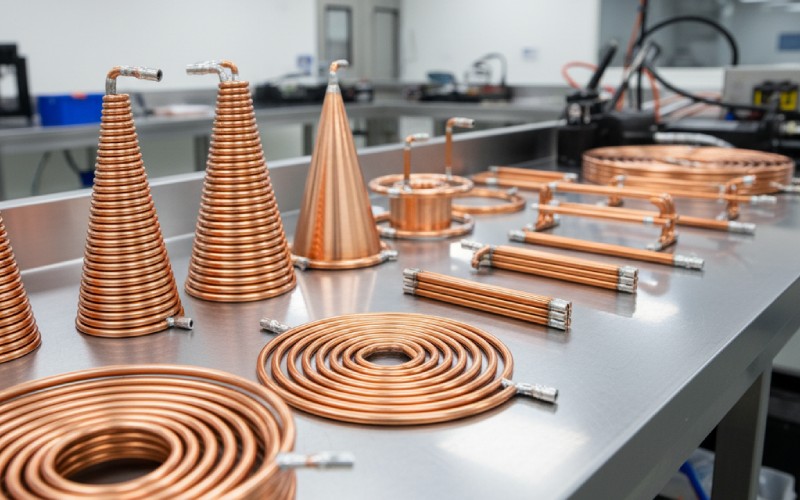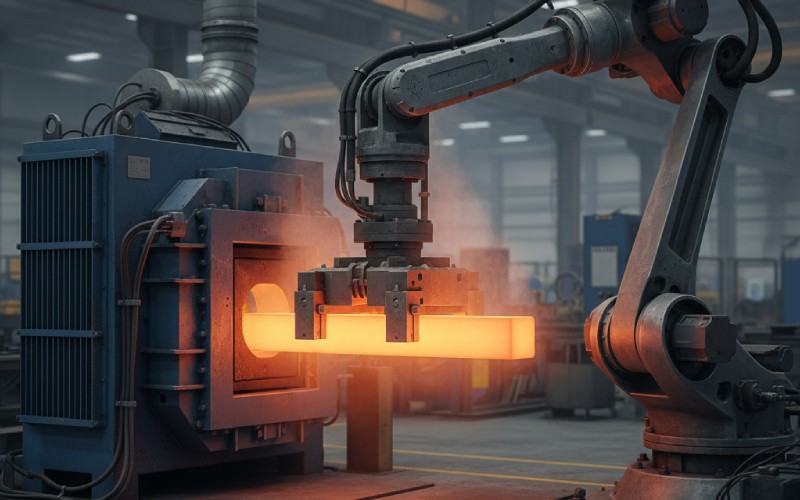Sino의 라미네이션 스택으로 프로젝트에 힘을 실어주세요!
프로젝트 속도를 높이기 위해 라미네이션 스택에 다음과 같은 세부 정보를 레이블로 지정할 수 있습니다. 허용 오차, 재료, 표면 마감, 산화 단열재가 필요한지 여부, 수량등 다양한 기능을 제공합니다.

어떻게 금속 조각이 불과 몇 초 만에 불 없이도 빨갛게 달아오를 수 있는지 궁금한 적이 있으신가요? 그것은 트릭이 아니라 과학입니다. 이를 유도가열이라고 합니다. 이 가열 방식은 빠르고 깨끗하며 매우 강력합니다. 전 세계의 많은 공장과 작업장에서 이 방법을 사용하고 있습니다.
이 기사에서는 인덕션 히터의 작동 원리를 정확하게 설명합니다. 쉬운 단어와 좋은 예를 사용하겠습니다. 이 훌륭한 기술에 대해 가장 먼저 알아야 할 사항을 배우게됩니다. 또한 일반적으로 구식 난방 방법보다 더 나은 선택 인 이유도 알 수 있습니다. 읽기를 마치면 오늘날 비즈니스에서 사용되는 매우 중요한 난방 도구를 이해하게 될 것입니다.
유도 가열의 기본은 쉽게 배울 수 있습니다. 유도 가열은 전기를 전달할 수 있는 물체를 가열하는 데 사용되는 과정입니다. 이것은 일반적으로 금속 조각입니다. 비접촉식 가열의 일종입니다. 즉, 가열하는 부품에 불이나 뜨거운 물체가 닿지 않는다는 뜻입니다. 대신 고유한 유형의 에너지를 사용하여 물체 내부에서 열을 발생시킵니다.
구리 튜브로 만든 특수 코일을 상상해 보세요. 이 코일을 통해 전류가 흐릅니다. 이렇게 하면 코일 주위에 자기장이 형성됩니다. 이 자기장에 금속 조각을 넣으면 놀라운 일이 일어납니다. 이 자기장으로 인해 아주 작은 전류가 금속 내부에서 원을 그리며 움직이게 됩니다. 이 전류는 마찰과 열을 일으킵니다. 이것이 바로 유도가열의 작동 원리에 대한 비밀입니다. 매우 직접적이고 에너지 절약적인 가열 방식입니다.
유도가열을 가능하게 하는 과학은 새로운 아이디어가 아닙니다. 유도의 역사는 오래 전인 1830년대에 시작되었습니다. 마이클 패러데이라는 과학자가 흥미로운 사실을 발견했습니다. 그는 변화하는 자기장이 전기를 전도하는 주변 물질에 전류를 유도할 수 있다는 사실을 발견했습니다. 이것이 바로 전기 모터부터 유도 열을 만드는 기계에 이르기까지 많은 것들이 작동하는 원리에 대한 주요 아이디어입니다.
오랫동안 이것은 과학자들에게 흥미로운 사실일 뿐이었습니다. 하지만 1900년대 초, 엔지니어들은 이 공정을 훨씬 더 강력하게 만드는 방법을 알아냈습니다. 그들은 최초의 유도 가열 시스템을 만들었습니다. 공장에서는 전쟁 중 탱크와 비행기의 부품을 만드는 데 이 시스템을 사용했습니다. 그 이후로 유도 가열 기술은 많이 향상되었습니다. 오늘날 유도 가열은 다양한 종류의 가열 응용 분야에 사용됩니다.
인덕션 히터에서 가장 중요한 부분은 인덕션 코일입니다. 이 코일은 가장 큰 역할을 합니다. 코일을 통해 교류 전류가 흐릅니다. 이로 인해 코일 주변에 매우 빠르게 변화하는 강한 자기장이 형성됩니다. 이 특별한 자기장, 즉 교류 자기장이 가열 과정을 시작합니다. 코일은 저절로 뜨거워지지 않습니다. 대신 그 안에 넣은 작업물을 매우 뜨겁게 만듭니다.
인덕션 코일 내부에 강철이나 구리와 같은 전도성 물질을 넣으면 두 가지가 함께 작용하여 인덕션 열을 발생시킵니다.

인덕션 히팅 시스템은 단순한 코일 그 이상으로 구성됩니다. 또한 두뇌와 동력 역할을 할 무언가가 필요합니다. 전원 공급 장치는 이 두 가지 역할을 모두 수행합니다. 전원 공급 장치는 벽면 콘센트에서 일반 전기를 가져옵니다. 그런 다음 유도 코일에 필요한 특수한 유형의 전기로 바꿉니다. 인덕션 전원 공급 장치는 인덕션 열을 제어하는 데 핵심적인 역할을 합니다.
전원 공급 장치는 주파수와 전력이라는 두 가지 주요 기능을 담당합니다. 주파수는 코일에서 전류가 얼마나 빨리 방향을 전환하는지 알려줍니다. 전력은 코일에 전송되는 총 에너지입니다. 작업마다 다른 설정이 필요합니다. 예를 들어 고주파 유도가열은 금속 부품의 외피에만 열을 발생시킵니다. 저주파 유도는 유도 열이 부품 깊숙이 가라앉을 수 있도록 합니다. 전원 공급 장치는 탱크 회로라는 특수 부품과 함께 작동합니다. 이 두 부품은 함께 정확한 양의 가열 전력을 보냅니다.
코일은 모든 인덕션 가열 작업에서 가장 중요한 부품입니다. 유도 가열 코일은 주요 가열 도구라고 생각하시면 됩니다. 코일의 모양과 크기에 따라 유도 열이 어디로 향할지 결정됩니다. 또한 공정이 얼마나 잘 작동하는지도 제어합니다. 좋은 코일 디자인은 훌륭한 결과를 얻기 위한 비결입니다. 코일의 모양이 부품에 맞지 않으면 에너지가 손실되고 결과가 좋지 않습니다.
주요 목표는 코일에 의해 생성된 필드가 에너지를 집중하도록 하는 것입니다. 가열해야 하는 작업물의 정확한 영역에 집중해야 합니다. 길고 곧은 막대의 경우 간단한 원형 가열 코일이 가장 적합합니다. 평평한 부품의 경우 평평한 "팬케이크" 코일이 더 나은 선택이 될 수 있습니다. 코일과 부품 사이의 공간도 매우 중요합니다. 부품이 코일에 가까울수록 더 많은 유도 열을 받게 됩니다. 코일은 매우 강한 전류를 생성합니다. 이러한 이유로 일반적으로 속이 빈 구리 튜브로 만들어집니다. 이를 통해 수냉을 사용하여 코일이 녹는 것을 방지할 수 있습니다.
유도 열을 사용하는 매우 일반적인 작업은 유도 경화입니다. 이는 금속 부품의 외부를 매우 단단하고 강하게 만드는 데 사용되는 방법입니다. 기어나 차축과 같은 부품은 마모되지 않도록 표면이 단단해야 합니다. 동시에 부품의 내부는 조금 더 부드러워서 금이 가지 않도록 해야 합니다.
인덕션 경화에는 특수 제작된 작업 코일이 사용됩니다. 부품의 표면만 빠르게 가열합니다. 유도 열은 매우 조심스럽게 조준됩니다. 단 몇 초 만에 표면이 매우 뜨거워집니다. 그 직후 물이나 오일을 사용하여 부품을 매우 빠르게 냉각시킵니다. 이렇게 빠르게 가열하고 냉각하면 금속이 표면에서 형성되는 방식이 바뀌어 매우 단단해집니다. 부품의 내부는 뜨거워지지 않으므로 부드러운 상태를 유지합니다. 이렇게 하면 견고한 부품과 오래 지속되는 표면이라는 두 가지 장점을 모두 얻을 수 있습니다.
예, 유도 용융은 유도 가열 기술을 사용하는 또 다른 매우 중요한 방법입니다. 금속 조각을 가열하는 데 사용되는 것과 동일한 아이디어를 녹이는 데에도 사용할 수 있습니다. 이런 종류의 작업에는 강력한 유도 가열 시스템이 사용됩니다. 도가니라는 특별한 냄비가 있습니다. 도가니 안에 전도성 물질을 넣고 도가니를 코일 안에 넣습니다.
강한 유도가열은 금속의 온도를 녹는 지점까지 빠르게 상승시킵니다. 유도가열의 특별한 용해 이점 중 하나는 자기장이 액체 금속을 교반하는 방식입니다. 이 교반 작용은 금속을 매우 잘 섞어줍니다. 그 결과 더 높은 품질과 균일한 최종 제품을 얻을 수 있습니다. 유도 용해 시스템은 깨끗하고 에너지를 많이 낭비하지 않습니다. 구형 용광로와 비교했을 때 열 손실이 거의 없습니다.
인덕션 가열을 가스 용광로나 화염 가열과 같은 오래된 가열 방법과 비교하면 큰 차이를 느낄 수 있습니다. 인덕션 가열은 인덕션 가열 산업의 많은 작업에 더 나은 선택이 될 수 있는 많은 장점이 있습니다.
다음은 주요 차이점을 보여주는 간단한 차트입니다:
| 기능 | 인덕션 히팅 | 전통적인 난방(화염 또는 용광로 등) |
|---|---|---|
| 속도 | 매우 빠릅니다. 단 몇 초 만에 물건을 가열할 수 있습니다. | 느립니다. 몇 분 또는 몇 시간이 걸릴 수 있습니다. |
| 에너지 사용 | 아주 잘 작동합니다. 80% 이상의 에너지가 부품을 가열합니다. | 잘 작동하지 않습니다. 많은 열 손실이 공기 중으로 빠져나갑니다. |
| 안전 | 훨씬 더 안전합니다. 모닥불이 없습니다. 불꽃 없는 난방입니다. | 위험할 수 있습니다. 화재, 화상, 유독가스의 위험이 있습니다. |
| 목표 | 매우 정확합니다. 원하는 부분만 가열합니다. | 정확하지 않습니다. 전체 부품과 그 주변의 공기를 가열합니다. |
| 청결 | 매우 깨끗합니다. 연기, 먼지, 쓰레기가 발생하지 않습니다. | 더러울 수 있습니다. 연기가 발생하고 청소가 필요합니다. |
| 제어 | 훌륭합니다. 열과 난방 시간을 쉽게 제어할 수 있습니다. | 좋지 않습니다. 열을 정확하게 제어하기 어렵습니다. |
보시다시피 인덕션 가열의 장점은 오늘날 물건을 만드는 데 있어 최고의 선택입니다. 유도가열은 더 스마트하게 사용할 수 있는 방법입니다.
사람들은 종종 가열 깊이에 대해 묻습니다. 유도 열이 실제로 금속 내부까지 얼마나 가열되나요? 이것은 매우 중요한 질문입니다. 이는 코일 내부의 교류 주파수에 의해 제어됩니다. 엔지니어는 가열의 침투 깊이를 매우 신중하게 제어 할 수 있습니다.
규칙은 매우 간단합니다:
적절한 주파수를 선택하면 유도 가열 시스템을 설정하여 필요한 정확한 지점에서 부품을 가열할 수 있습니다. 이러한 수준의 제어는 인덕션 가열의 가장 큰 장점 중 하나입니다.

지금까지 유도가열의 좋은 점에 대해 많이 이야기했습니다. 유도가열의 주요 장점을 기억하기 쉽도록 목록으로 정리해 보겠습니다. 유도 가열을 사용하면 작업장과 공장에 많은 이점을 제공합니다.